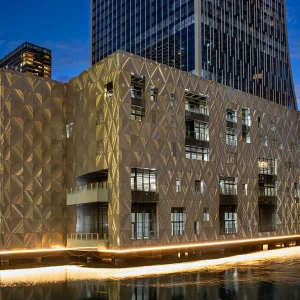
We wish we had more posters to give away! Over 60 people entered the competition with a quarter of entrants hailing from Preston itself. That must speak volumes about the building (not to mention that there were a few entries from Building Design Partnership as well!) Fittingly, the poster is now winging it’s way to one of the Prestonians, Michelle Cornwell. Enjoy.
Here’s a taster of Herbert Wright’s article on the history of English Heritage, with the full version appearing in the latest issue of Blueprint (#331).
This year English Heritage celebrated its centenary… or was it really its 30th anniversary? After all, Michael Heseltine set up the quango as recently as 1983 to safeguard the best of England’s built legacy, a function previously entrusted to his Department for the Environment. Then again, what about the 120th anniversary of the appointment of the first Inspector of Ancient Monuments? Or the first Ancient Monuments Protection Act, which became law in 1882?
At his London offices in a magnificently gothic late-Victorian complex designed by Alfred Waterhouse, the youthful and energetic chief executive of English Heritage since 2002 Simon Thurley clarifies: the 1913 Act ‘establishes the power of the state to make a list of historic properties that are worthy of protection, and it gives power to government to make a collection of buildings for public benefit and education’.

Although still 70 per cent state funded, English Heritage also has income from a membership of 750,000, visitors to 420 sites (mainly free to enter, but there are gift shops, cafes and such like) and donations. In July, the Government awarded it £80m to spend on urgent repairs and to get plans moving for a self-financing charity to continue looking after its national heritage collections, which range from palaces to prehistoric circles and includes an archive of 10 million photographs, plans and surveys. English Heritage advises government on listing historic buildings (see page 118) and planning applications, as well as issuing grants, managing maritime archeology and erecting London’s blue plaques. Not least, the organisation connects the public to England’s historic environment.
In the past, English Heritage has perhaps overstretched those responsibilities. It led the campaign against London’s skyscrapers Heron Tower and The Shard. Public inquiries in 2002 and 2003 cost £21m and hinged on views of St Paul’s Cathedral. Thurley’s opinion is that ‘it’s our job to represent the views of a large number of people who feel uncomfortable about these types of buildings’, something that he sees as intrinsic to the democratic process. The then London mayor Ken Livingstone, keen for developers’ investment and a modern skyline, told a property conference in 2002 that English Heritage was ‘an obscure monastic order’ and that ‘a decisive defeat of English Heritage is vital’. Livingstone got his defeat, twice, but as for his language, Thurley says, ‘It made me laugh at the time and it still makes me laugh now. English Heritage is still here; where is Ken Livingstone?’
Arguably, his presence lingers in the legacy of London’s world-city supremacy, and certainly in its ongoing high-rise boom. In June, Thurley argued passionately at the Council on Tall Buildings and Urban Habitat skyscraper conference (Blueprint 330, September/October 2013) against the Chipperfield-designed redevelopment plans for Elizabeth House, Waterloo, because of its impact on views, but he is not intrinsically intolerant of skyscrapers per se. Referring to the Leadenhall Building, aka the Cheesegrater (Blueprint 325, April 2013), he says, ‘We have had very good, robust, positive conversations with [its developer] British Land… and we feel that building will make a positive contribution to the skyline.’
A similar argument brewed recently with the Peel Group’s Liverpool Waters plans to redevelop docks just north of the city’s UNESCO-designated World Heritage Site, with a cluster of skyscrapers. Thurley contends that Liverpool ‘has to decide what they want… the big badge of the World Heritage Site, or a massive great thing next door, which many people feel will detract from that badge that they have. They can’t have both. We are just astonished that the developer feels that it needs to press a scheme which is unsympathetic’. In any case, he muses that selling even two of ‘the sort of chi-chi two-bedroom flats in those blocks will be a real struggle, let alone 2,000 of them.
I think we’re in a little bit of a cloud cuckoo land here with the whole of this big scheme’. The Government approved the plans in March this year. Thurley recognises Liverpool’s need for investment and jobs, but points out that Wirral Waters, Peel’s almost-mirror scheme across the Mersey, is something ‘which we felt content with… they can start building tomorrow’.
English Heritage and UNESCO were in tune about Liverpool, but Thurley admits that they haven’t always seen eye-to-eye. ‘UNESCO has to realise that it’s not like dealing with a country where conservation is seen as an impediment,’ he comments. The UN organisation is not the only difficult team-mate that English Heritage has had. While he’s ‘very pleased’ with the current Culture Minister Ed Vaizey, to whom listing recommendations go, the previous minister Margaret Hodge was someone ‘who I got on with personally extremely well but I did fundamentally disagree with her almost visceral hatred of British brutalism of the Seventies’. Post-war buildings account for barely 650 of the total 374,000 listings, but Thurley is passionate about British brutalism in particular. He feels the Seventies was his era, ‘when I had hair and wore stacked shoes’. He’s wanted to ‘do a dance’ for every brutalist building listed, and he talks of the ‘extraordinary emotional effect’ they produced.
He is bitter about Birmingham Library, completed in 1974 (Blueprint 330), which English Heritage thrice recommended for listing to no avail. ‘A tragic story’ is how he describes its architect, John Madin, ‘who bestrode the second city of Britain, whose designs, buildings, and town planning skills were admired around the world… He died last year knowing that not one single building will be standing in five years’ time’. That’s a slight exaggeration, but point taken. Thurley laments similar cases such as Owen Luder — ‘his car parks in Gateshead and Portsmouth: gone’. Despite the recognition of (listed) Centre Point’s brilliance, he worries that even ‘Richard Seifert could easily fall into the Madin category’. To those who dismiss brutalist icons as carbuncles to be rid of, he cites Victorian icons that earlier generations felt similarly about: St Pancras (‘a building that was listed to the complete horror of British Rail and half the public’, he notes) or Manchester’s inner-city warehouses (their listing provoked ‘accusations that this would consign Manchester to be a museum, it would fossilise Manchester’). Tastes change and, Thurley says, ‘it is our role partly to follow fashion, but partly to lead fashion’. He wants future generations to ‘experience some of the awe that you feel when you confronted by British brutalism in the Seventies’.
English Heritage’s future is now reaching into the deep past. ‘A hundred years ago,’ Thurley notes, ‘one of the main reasons that Act of Parliament was passed was because people were so desperate to sort out Stonehenge… I’m very proud that we seem to be the generation that cracked the nut.’ The solution to that previously resistant nut includes an extraordinarily contemporary visitor centre by Denton Corker Marshall (see page 126). In what Thurley calls the ‘great outdoor museum of national history’ that is English Heritage’s realm, the crowning glory of his reign will lie in those Wiltshire fields.
Words by Herbert Wright





